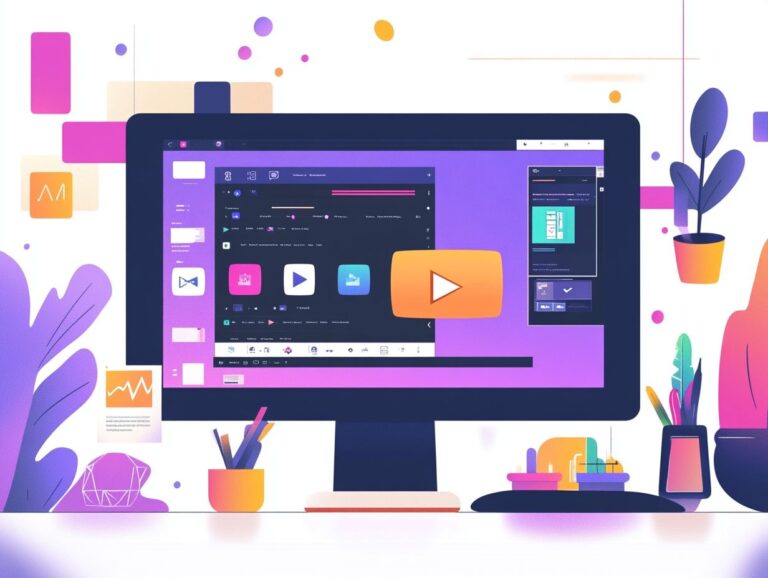How to Summarize a Youtube Video Using AI?
Video summarization is a technique used to create a condensed version of video content, which can include clips, shows, or even live streams. This technique extracts essential information from longer videos to produce a shorter version that retains only the necessary details.
There are various methods of video summarization, and in this article, we will explore these methods as well as provide a step-by-step guide on how to summarize YouTube videos.
Additionally, we will discuss the benefits of summarization, including its potential to save time and deliver more accurate information.
Contents
- Key Takeaways:
- What Is Video Summarization?
- What Are The Different Types Of Video Summarization?
- How Does AI Help In Video Summarization?
- What Are The Steps To Summarize A YouTube Video Using AI?
- What Are The Benefits Of Using AI For Video Summarization?
- Frequently Asked Questions
- How do I summarize a Youtube video using AI?
- Can I summarize any type of Youtube video using AI?
- How accurate are AI-generated summaries of Youtube videos?
- Do I need any technical skills to use AI for summarizing Youtube videos?
- Are there any free AI tools for summarizing Youtube videos?
- Can I edit the AI-generated summary of a Youtube video?
Key Takeaways:
What Is Video Summarization?
Video summarization is the process of condensing video content into shorter formats using advanced AI technologies that produce AI-generated summaries. These summaries capture the essential elements of the original material while retaining key aspects.
Sophisticated video summarization algorithms extract important points, generate in-depth highlights, and create segmented summaries, making it easier to comprehend the transcripts of video content. Notta YouTube is one of several AI tools that utilize these techniques, providing users with quick access to the key insights of video content in a convenient and time-efficient manner.
Consequently, video summarization tools are becoming invaluable resources for students, researchers, and professionals seeking to process the vast amounts of audiovisual content available today.
Why Is It Important?
Video summarization plays a crucial role in today’s landscape of educational content and how-to guides. It enables viewers to quickly access key information, facilitating the summarization of lectures and tutorials while allowing them to grasp complex topics more efficiently.
Additionally, video summarization tools enhance content accessibility, helping users internalize essential insights while ensuring privacy protection.
What Are The Different Types Of Video Summarization?
Video summarization encompasses various methods tailored to meet specific needs, with keyframe summarization, motion-based summarization, object-based summarization, and semantic-based summarization being the primary types utilized by modern AI tools.
Each type serves its own purpose and is designed to extract the most crucial elements of video content. This capability allows users to quickly summarize any video, whether for educational purposes, entertainment, or research.
1. Keyframe Summarization
Keyframe summarization involves selecting the most important frames from a video to capture its essence while eliminating irrelevant parts. This process utilizes video analysis tools to identify keyframes and highlights, providing viewers with a concise and relevant summary of the video. By pinpointing significant moments, keyframe summarization enhances content consumption and user engagement. For instance, a video summarization tool can extract essential ideas and examples from an instructional video, allowing users to quickly access the information they need.
In the realm of entertainment, video summarization is employed by streaming services to create trailers that showcase the most compelling aspects of a movie or show. This strategy entices viewers to watch the content without requiring them to view the entire video.
Examples of Purpose:
- Educational Videos: Video summarization aids in identifying key ideas and learning points in instructional videos, enabling users to quickly grasp the essential information they seek.
- Entertainment: Video summarization facilitates the creation of trailers for movies or shows by highlighting the most important and engaging scenes, encouraging users to watch the content without needing to view the entire video.
2. Motion-based Summarization
Motion-based summarization identifies the key elements of a video by analyzing the movements within it. This technique enables quick summarization by emphasizing dynamic changes and actions.
It is particularly useful across various video formats, such as podcasts, webinars, and marketing videos, where visual storytelling plays a significant role. By filtering out static or unhelpful scenes, this approach ensures clearer content, allowing viewers to concentrate on the core message.
Efficient summarization not only highlights important moments but also preserves the contextual integrity of the video, helping viewers retain information and draw meaningful conclusions.
3. Object-based Summarization

Object-based summarization is a technique that involves recognizing and analyzing specific objects within a video to create a selective summary that highlights the role and significance of these objects in the overall storyline. This approach is particularly beneficial in educational and instructional videos, where understanding the relationships between objects is crucial.
Object-based summarization simplifies the extraction of relevant information from complex video content, allowing users to concentrate on the most important aspects without having to watch extensive footage. By employing object recognition and tracking algorithms, this technique enhances user engagement and provides a richer context regarding the significance of each object, which is especially valuable in fields such as e-learning, advertising, and research.
The ability to summarize videos based on key objects facilitates faster information retrieval, improves content retention, and supports better decision-making processes, making video content more accessible and actionable.
4. Semantic-based Summarization
Semantic-based summarization employs AI-powered techniques to analyze the meaning and context of a video’s message, offering a multi-dimensional summary that captures its core essence.
This approach prioritizes the semantics of dialogues, visuals, and actions to ensure that the summary remains both concise and contextually relevant.
In contrast to traditional summarization methods, which often focus on keyword extraction or simple sentence compression, semantic-based techniques delve deeper into the narrative structure and thematic elements of the video.
This advanced methodology enhances user understanding by delivering information that aligns with user experience and intent.
By utilizing complex algorithms to analyze spoken words and relevant images, users gain a more comprehensive insight into the content.
Thus, semantic-based summarization not only facilitates quick content consumption but also offers an immersive learning experience that better meets users’ informational needs.
How Does AI Help In Video Summarization?
AI plays a crucial role in video summarization by leveraging advanced technologies that enhance transcription features and improve voice recognition accuracy. This leads to more effective video summarization.
By analyzing both audio and visual elements in real-time, AI tools are capable of generating comprehensive summaries that accurately represent the content of videos, ultimately saving users time and effort.
What Are The Techniques Used By AI For Video Summarization?
AI employs techniques such as real-time transcription, keyword extraction, and context analysis for video summarization. By utilizing these advanced features, AI can identify key segments and streamline the summarization process, ultimately enhancing the overall user experience.
Real-time transcription converts the spoken terminology in a recorded video into text, allowing the AI to pinpoint important statements and topics, ensuring that essential content is included in the summary. Keyword extraction highlights key themes and concepts, enabling viewers to quickly grasp the main ideas without having to sift through unnecessary details.
Meanwhile, context analysis allows the AI to understand the relationships between different elements in the video, ensuring that the selected segments are not only relevant but also form a coherent sequence. The combination of these techniques results in summaries that align with viewer preferences and effectively communicate key information.
What Are The Steps To Summarize A YouTube Video Using AI?
The process of summarizing a YouTube video using AI involves several steps.
- First, users should choose an AI-powered YouTube video summarizer tool.
- This type of tool reads the video transcript, extracts key highlights, and generates concise summaries that focus on the most important aspects of the video.
Step 1: Pre-processing The Video
The first step in using an online video summarizer to summarize a YouTube video is pre-processing the video, which typically involves extracting the video transcript and preparing the data for analysis. This step is crucial because improper processing can prevent the AI from accurately analyzing the content and generating a quality summary.
The pre-processing stage may include several actions aimed at improving the quality of the input data. These actions can involve:
- Noise reduction to enhance audio clarity by filtering out irrelevant sounds or disturbances,
- Format conversion to change the video into a more analyzable format, and
- Metadata integration to provide contextual information that aids in summarization.
By implementing these steps, the subsequent video processing can occur smoothly and accurately, ultimately leading to the creation of an effective and informative video summary.
Step 2: Extracting Key Frames

The second step in the video summarization process is keyframe extraction, which is crucial for identifying key moments that best represent the video’s overall message. Keyframe summarization is essential for creating meaningful highlights that resonate with audiences.
Various methods, including visual saliency detection, abrupt scene change algorithms, and motion analysis, are employed to identify the most significant moments for extraction. Factors considered during this extraction process include emotional intensity, visual quality, and relevance to the story. The key moments selected are those that viewers are statistically more likely to engage with.
By extracting these key moments, the summarization process is enhanced, improving retention and the overall narrative flow. This approach allows viewers to quickly grasp the video’s essence. A well-chosen selection of key moments can significantly boost viewer engagement and interaction.
Step 3: Identifying Important Objects And Actions
The third step involves defining the primary objects and actions within the video. Techniques like object-based summarization and motion-based summarization are employed to identify interactions and movements. This approach ensures that the summary highlights the most relevant aspects of the video’s narrative.
Step 4: Generating A Summary
AI generates a summary by first creating key frames and identifying relevant objects and actions, effectively compiling all essential information to produce a coherent overview of the video’s content in a condensed form. This summarization process allows users to quickly extract key points that convey the overall message of the source video in a short amount of time.
Advanced algorithms analyze multiple parameters, including visual data and audio cues, to identify important events and themes. Subsequently, natural language processing techniques are employed to present the compiled information in an easy-to-read format, typically as bullet points or as a narrative summary.
This format enhances usability, enabling users whether they are students, professionals, or casual viewers to grasp important messages quickly without spending excessive time watching lengthy videos. Therefore, the summary serves not only as a reference but also as a strategic approach to improve understanding and facilitate effective information retention.
What Are The Benefits Of Using AI For Video Summarization?
The advantages of AI in video summarization include significant time and effort savings for users who need to quickly consume large volumes of video content.
AI tools deliver accurate and objective summaries, are capable of processing extensive datasets, and can be customized to meet specific requirements.
1. Saves Time And Effort
The primary advantage of AI video summarization is the significant savings in time and effort. Users can leverage AI to quickly summarize videos without needing to watch or listen to the entire content of lengthy videos. This capability is particularly beneficial for professionals and students who must absorb large amounts of information in a limited timeframe.
For instance, a busy executive may need to sift through hours of meeting footage to extract key talking points and decisions for an internal report. AI summarization tools can accomplish this task in minutes by scanning the footage and identifying the most important moments and action items.
Similarly, a student preparing for exams can utilize AI summarization tools to quickly capture essential lectures without engaging in lengthy note-taking sessions. This method can enhance students study routines, making them smoother and more productive.
In both instances, AI enables users to increase their productivity, allowing them to focus more on applying and executing their knowledge, thereby optimizing the learning experience while reducing the time spent on content consumption.
2. Provides Accurate And Objective Summaries
AI offers accurate and objective summaries that encapsulate the main concepts and highlights of the original video content, thereby minimizing human bias and errors. With high voice recognition accuracy and contextual understanding, AI-generated summaries enable users to trust the information they receive.
The ability to distill complex information into concise and clear summaries is vital in today’s fast-paced information landscape. By leveraging advanced algorithms, AI can analyze both verbal and visual cues from videos, identifying key themes and relevant data while filtering out extraneous details.
For instance, when summarizing a lecture or webinar, the technology focuses on essential arguments and conclusions without the influence of a human editor’s subjective interpretation. This level of objectivity not only enhances the accuracy of the material but also give the power tos users to make informed decisions based on unbiased information, ultimately promoting a more equitable presentation of knowledge.
3. Can Handle Large Amounts Of Data

AI-driven tools are capable of managing vast amounts of data, enabling users to summarize large volumes of video content in a timely and efficient manner. With their advanced transcription capabilities and video analysis features, these tools simplify the process of summarizing extensive data, allowing users to extract insights from longer videos without compromising quality.
This functionality is particularly beneficial for professionals and researchers who regularly work with large video databases, as it significantly reduces the time required to locate relevant segments. These intelligent systems employ sophisticated algorithms to detect patterns, categorize data, and assign importance to content based on user-defined criteria.
As a result, users can condense substantial amounts of audiovisual information into concise summaries, facilitating quicker decision-making and enhancing productivity. By automating data handling and providing contextual summaries, AI enables individuals to focus on higher-value activities instead of sifting through excessive footage.
4. Can Be Customized For Specific Needs
AI-powered summarization tools can be tailored to meet specific needs. Users have the ability to customize the summaries produced by these tools according to their preferences or the contextual requirements.
The advanced features offered by these tools, combined with their user-friendly interfaces, ensure that all users can easily adjust options to create summaries that align with their expectations. For instance, users can specify the desired length of the summary, ranging from brief snippets to more comprehensive overviews, based on their current needs.
Many tools also allow users to modify the output tone, whether formal or casual, depending on the intended audience. Additionally, some platforms enable users to provide keywords or themes to emphasize, further enhancing the overall experience.
By customizing elements such as tone and level of detail, AI summarization tools can be extremely beneficial for students, professionals, and academics seeking to quickly identify relevant information.
Frequently Asked Questions
How do I summarize a Youtube video using AI?
To summarize a Youtube video using AI, you can use various online tools and software specifically designed for this purpose. Simply copy and paste the video’s link into the tool, and it will provide a summarized version of the video for you.
Can I summarize any type of Youtube video using AI?
Yes, most AI tools are capable of summarizing any type of Youtube video, including tutorials, vlogs, music videos, and more. However, the accuracy of the summary may vary depending on the complexity and quality of the video.
How accurate are AI-generated summaries of Youtube videos?
The accuracy of AI-generated summaries can vary depending on the tool or software used and the complexity of the video’s content. However, most AI tools are constantly improving and can provide fairly accurate summaries.
Do I need any technical skills to use AI for summarizing Youtube videos?
No, using AI to summarize Youtube videos is a simple and user-friendly process. You do not need any technical skills to use the tools, and most of them have a user-friendly interface that makes the process easier.
Are there any free AI tools for summarizing Youtube videos?
Yes, there are several free AI tools available online that can help you summarize Youtube videos. However, they may have limitations in terms of the length of the video or the accuracy of the summary.
Can I edit the AI-generated summary of a Youtube video?
Yes, most AI tools allow you to edit the generated summary to make it more accurate or to better suit your needs. You can add or remove sentences, change the order of the summary, or even paraphrase certain parts if needed.






